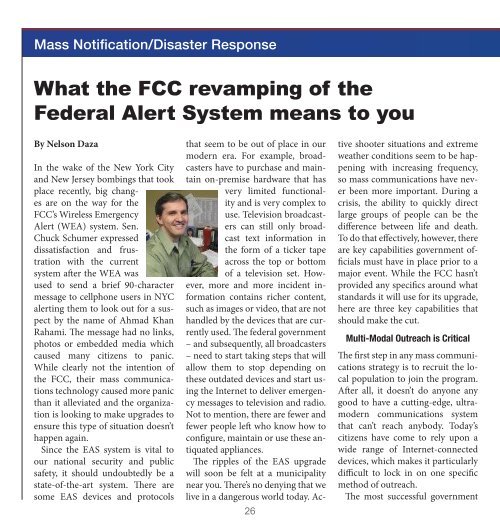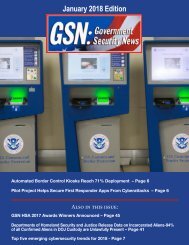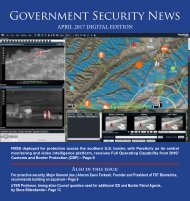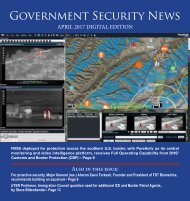GSN_Nov-Dec_FINAL_Yumpu
Create successful ePaper yourself
Turn your PDF publications into a flip-book with our unique Google optimized e-Paper software.
Mass Notification/Disaster Response<br />
What the FCC revamping of the<br />
Federal Alert System means to you<br />
By Nelson Daza<br />
In the wake of the New York City<br />
and New Jersey bombings that took<br />
place recently, big changes<br />
are on the way for the<br />
FCC’s Wireless Emergency<br />
Alert (WEA) system. Sen.<br />
Chuck Schumer expressed<br />
dissatisfaction and frustration<br />
with the current<br />
system after the WEA was<br />
used to send a brief 90-character<br />
message to cellphone users in NYC<br />
alerting them to look out for a suspect<br />
by the name of Ahmad Khan<br />
Rahami. The message had no links,<br />
photos or embedded media which<br />
caused many citizens to panic.<br />
While clearly not the intention of<br />
the FCC, their mass communications<br />
technology caused more panic<br />
than it alleviated and the organization<br />
is looking to make upgrades to<br />
ensure this type of situation doesn’t<br />
happen again.<br />
Since the EAS system is vital to<br />
our national security and public<br />
safety, it should undoubtedly be a<br />
state-of-the-art system. There are<br />
some EAS devices and protocols<br />
26<br />
that seem to be out of place in our<br />
modern era. For example, broadcasters<br />
have to purchase and maintain<br />
on-premise hardware that has<br />
very limited functionality<br />
and is very complex to<br />
use. Television broadcasters<br />
can still only broadcast<br />
text information in<br />
the form of a ticker tape<br />
across the top or bottom<br />
of a television set. However,<br />
more and more incident information<br />
contains richer content,<br />
such as images or video, that are not<br />
handled by the devices that are currently<br />
used. The federal government<br />
– and subsequently, all broadcasters<br />
– need to start taking steps that will<br />
allow them to stop depending on<br />
these outdated devices and start using<br />
the Internet to deliver emergency<br />
messages to television and radio.<br />
Not to mention, there are fewer and<br />
fewer people left who know how to<br />
configure, maintain or use these antiquated<br />
appliances.<br />
The ripples of the EAS upgrade<br />
will soon be felt at a municipality<br />
near you. There’s no denying that we<br />
live in a dangerous world today. Active<br />
shooter situations and extreme<br />
weather conditions seem to be happening<br />
with increasing frequency,<br />
so mass communications have never<br />
been more important. During a<br />
crisis, the ability to quickly direct<br />
large groups of people can be the<br />
difference between life and death.<br />
To do that effectively, however, there<br />
are key capabilities government officials<br />
must have in place prior to a<br />
major event. While the FCC hasn’t<br />
provided any specifics around what<br />
standards it will use for its upgrade,<br />
here are three key capabilities that<br />
should make the cut.<br />
Multi-Modal Outreach is Critical<br />
The first step in any mass communications<br />
strategy is to recruit the local<br />
population to join the program.<br />
After all, it doesn’t do anyone any<br />
good to have a cutting-edge, ultramodern<br />
communications system<br />
that can’t reach anybody. Today’s<br />
citizens have come to rely upon a<br />
wide range of Internet-connected<br />
devices, which makes it particularly<br />
difficult to lock in on one specific<br />
method of outreach.<br />
The most successful government















